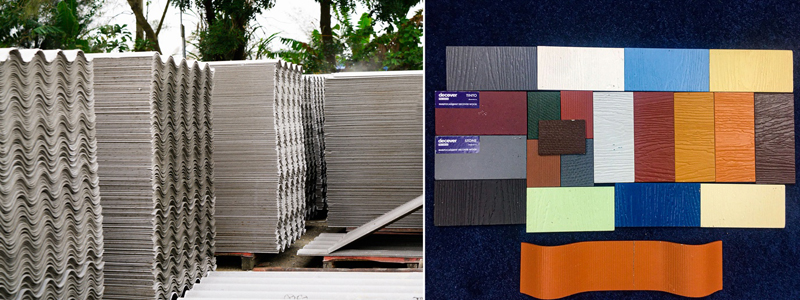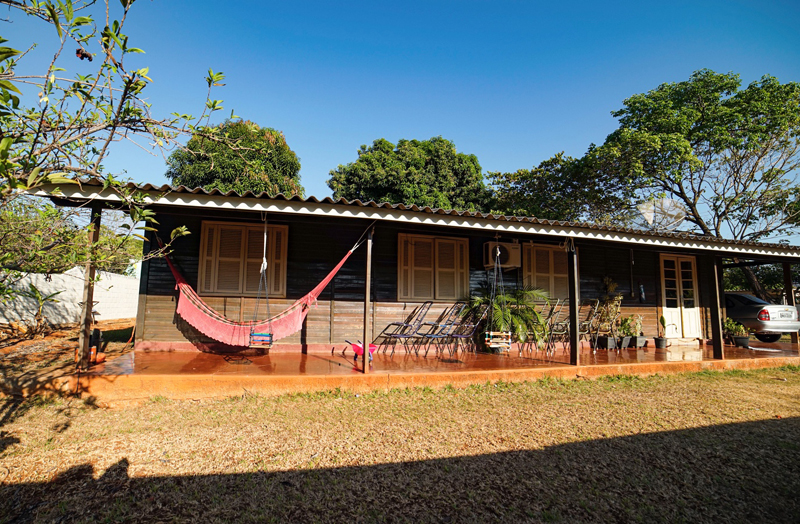
Photos of traditional AC roof sheets and new types of cheap fibro cement sheets.
While debate on the effects of chrysotile has not ended, factories in the industry of producing AC roof sheet, a product with various utilities and appropriate for social security, are teetering on the edge of closing down.
So, what are the reasons? More than 20 years of production with the ban hanging overhead, businesses producing AC roof sheets do not die immediately but dying slowly. No one dares to invest in technology and diversify products because of the fear that every efforts and money will be down the drain.
But without any investment, traditional roofing products with only one gray color cannot continue to compete and meet the trend of Vietnamese consumers – where more than 70% of the population are poor and have low income. The market demands a cheap sheets with eye-catching colors, diverse designs, soundproof, fireproof, good expansion in sudden changing weather conditions, not rusty in the marine environment, in hoarfrost, cattle or poultry cages.
Looking for a more compelling reason to prohibit chrysotile?
On July 22, 2019, VNRA sent the document No. 07/BC-HHTLVN to departments and agencies of the Communist Party and the Government to propose that the reasons for prohibition on chrysotile to protect people’s health are not entirely convincing.
From 2009 to 2011, the Ministry of Health, Labor and Welfare of Japan, through the World Health Organization (WHO), sponsored the Vietnam of Health Environmental Management Agency – the Ministry of Health to implement the topic “Researching on Asbestos-related diseases in exposed people”. The result showed that among 39 samples after screening were sent to Hiroshima Hospital for diagnosis, there was no case of disease caused by occupational exposure to asbestos detected.
Meanwhile, according to the Ministry of Health statistics: until 2015, in the building materials industry, the number of people infected with pneumoconiosis was 20,993 cases, in which silicosis accounts for 74.2%. This is a pathological condition in the lung caused by inhalation of silica particles that appear in the quarrying industry, cement production, refractory bricks, fine art stone production, coal mining, metallurgy, etc.
WHO statistic shows that there are 60,000 people died from air pollution in Vietnam or 79,000 people died from drinking alcohol in 2016. Particularly for lung cancer, the International Agency for Research on Cancer (IARC) – a member of WHO – recorded 20,710 deaths in Vietnam in 2018 and the main causes included smoking, drinking, obesity, inactivity and improper uses of fuel.
Another reason to ban chrysotile is that there are better alternatives such as PVA fibers from Japan. However, VNRA affirmed that there are two pilot enterprises, of which Navifico had been closed for 2 years, while Tan Thuan Cuong factory had to switch back to producing AC roof sheets to cover the costs of workers’ wages and the operation of the factory. PVA fiber sheets have high cost and easily broken. In fact, Vinh Chau villag – Soc Trang, which was supported Navifico’s 12,000 PVA roof sheets by the World Bank in 2004, had to remove almost entirely its PVA root sheets because they could not stand the coastal climate condition.
VNRA has to raise a question whether the targets of the campaign to ban chrysotile are merely for public health or for other reasons such as commercial competition, establishing market for alternative materials, seeking profits from anti-asbestos activities such as lawsuits, attorney fees, etc.
Countries that are still safely using asbestos
Asbestos is still being used in more than 130 countries and regions such as the US, Russia, China, India, ASEAN countries, etc.
The American asbestos industry has been in development since 1858. Brown and blue asbestos in particular was used massively and uncontrollably in the US, resulting in thousands of patients suffering from cancer due to exposure them. Asbestos was banned in the US in 1989, but in 1991, the US Supreme Court canceled the ban on chrysotile as there was no clear evidence for the effects of chrysotile asbestos and this fiber remained as an irreplaceable material in many products, especially in the automotive, aerospace industries and national defense.
Brazil is the third largest chrysotile producing country in the world after Russia and China. It is also one of the leading asbestos consuming countries, of which 54% is exploited for domestic consumption and 46% of production is for exports. While the per capita use rate of Canada is 500g/person, the US is 100g/person, Brazil has the usage rate up to 1,400g/person.
Studies on chrysotile in water have not found its pathogenicity. Especially in Brazil, where there are 60% of people still use drinking water stored in AC tanks.

AC roofing houses in Minaçu – Brazil.
Asbest City in Yekaterinburg Province, Russia, is the largest place of chrysotile exploitation in the world. After 130 years, Asbest became home to 80,000 residents. The health indicators of this city are always on average level like other regions in Russia. No cancer cases have been reported due to exposure to chrysotile when the city has applied safe practices.
Similarly, India rejected the proposal to ban the use of chrysotile since there is no conclusive evidence on the impact of chrysotile on people’s health. The asbestos industry in India still strictly abides by regulations to ensure occupational safety and health for workers.
In the Europe, asbestos-containing pipes are still in use. For example, Germany is still using 50,000km of asbestos-containing pipes.





